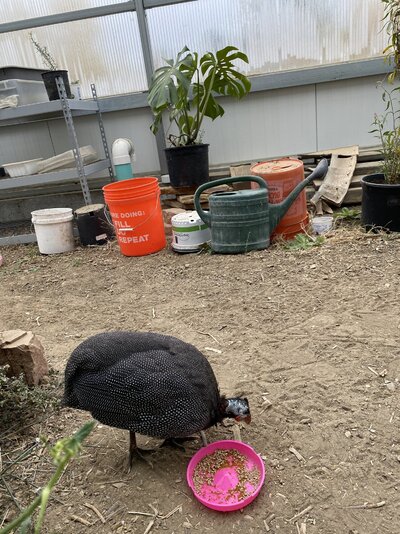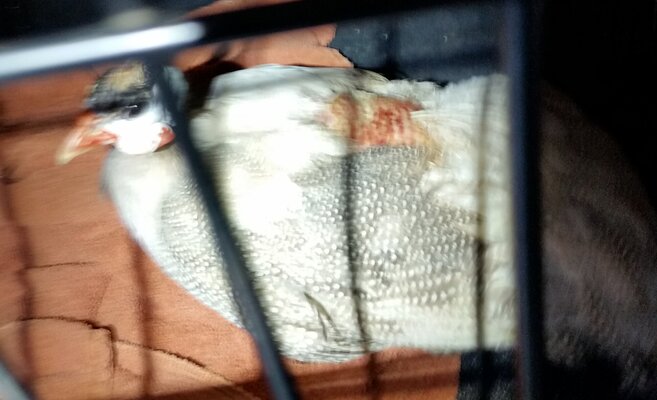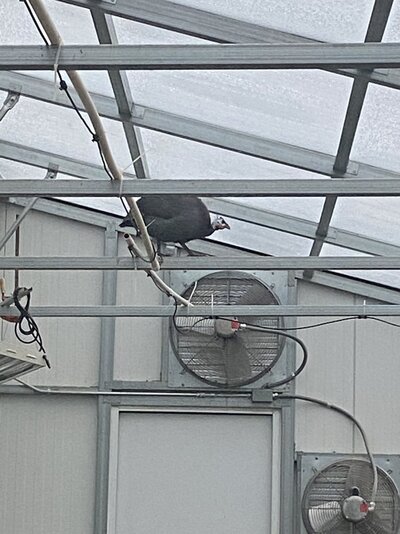tranquiliti
Crowing
On Oct 20, I emailed the Colorado State University vet school’s exotics group to describe the injury that had occurred the previous day. (Email pasted below in a different font.)
Since I never heard back either by email or phone, I sought information elsewhere—including a remote avian vet who assured me near the end of last week that as long as my bird is able to eat/drink/fly I should be able to let her out with the others.
Over the course of the week I’ve been able to obtain Nutri-Drench (used x1 so far), Blu-Kote, and some other items but nothing has gotten the regular use that Blu-Kote has. Unfortunately, the brief amount of time that all of the birds were together earlier today resulted in a fresh opening to the wound on Bird’s neck, which I addressed by spraying more Blu-Kote and isolating her back in the greenhouse.
Today happened to be when the Baytril 10% I ordered from allbirdproducts.com arrived, and this afternoon I mixed 0.2mL into a quart-size clean jar of tap water for Bird to drink.
I could only stare at her for so long… but in the hour or two since preparing it, I saw Bird take two separate trips to the fount, drinking both times. Hopefully keeping an infection at bay will allow for healing.
————
Hello,
We are caring for four guinea fowl at an age of 16 weeks (purchased Jun 29 as keets from Feeders Supply in Fort Collins). They are accustomed to their humans supplying shelter (locked in coop nightly), daily gamebird meal ration, and comfort while foraging outdoors. The birds do not roam very far, despite >30 acres available to them—preferring to do their foraging under supervision.
As expected for their species, they have not attained the standard definition of domesticated, maintaining a wariness for any direct handling. One suspected cockerel is the tamest of the four and historically has been the subject of assertive pecking from the other birds; whether this is the result of his willingness to interact with humans is unknown.
However, approximately 24 hours ago on the 19th of October, I released the four birds from their coop after a mild rainstorm passed by. They had been locked inside for about 3 hours due to restlessness as the storm approached: demonstrated by frequenting the front stoop of the house where they observe their reflections in the windows and call to any visible humans inside. No abnormalities were noted, aside from one particular bird that was favoring her right leg, and even inspecting the palmer surface for what may have been a thorn.
It had become late afternoon when I had the chance to envelop the injured bird in my arms so that I could examine her foot—which is when the massive injury to the right dorsal portion of her neck was observed, the source for the wound unknown.
First-aid debridement and pressure to the wound site were performed: there was an active bleed emerging from beneath the inferior right border of the wound. She resisted application of any gauze pads or bandages to her neck, but by nightfall the bleeding had resolved, and a heavy layer of triple-antibiotic ointment was applied to the wound.
The patient was isolated in a greenhouse adjacent to the barn which contains the birds’ coop, where she was able to drink water, a second fount containing an electrolyte mixture titled Hydro-Hen; and her feed supply included Purina Game Bird Flight Conditioner, millet seed, and a small amount of “Ultrakibble for Chicks” which has both molasses and salmon meal.
Due to the below-freezing outdoor temperatures, the birds were not seen until about 9:00am this morning. The patient was perched on a ceiling support beam, in a similar position to where I had left her late last night when she flew there herself. She has a strong survival instinct, and although I am relieved that she made it through the cold night after an injury I am most concerned about wound healing and infection prevention, with a secondary desire to provide pain relief if it will aid her recovery.
I have spent several years in pharmacy school and although resources are plentiful for elucidating optimal medication management for humans, I’m at a loss when it comes to this poor bird.
Should I have tried to humanely end her life last night? Is surgery an option or is open-wound monitoring & treatment under isolation the only choice?
Since I never heard back either by email or phone, I sought information elsewhere—including a remote avian vet who assured me near the end of last week that as long as my bird is able to eat/drink/fly I should be able to let her out with the others.
Over the course of the week I’ve been able to obtain Nutri-Drench (used x1 so far), Blu-Kote, and some other items but nothing has gotten the regular use that Blu-Kote has. Unfortunately, the brief amount of time that all of the birds were together earlier today resulted in a fresh opening to the wound on Bird’s neck, which I addressed by spraying more Blu-Kote and isolating her back in the greenhouse.
Today happened to be when the Baytril 10% I ordered from allbirdproducts.com arrived, and this afternoon I mixed 0.2mL into a quart-size clean jar of tap water for Bird to drink.
I could only stare at her for so long… but in the hour or two since preparing it, I saw Bird take two separate trips to the fount, drinking both times. Hopefully keeping an infection at bay will allow for healing.
————
Hello,
We are caring for four guinea fowl at an age of 16 weeks (purchased Jun 29 as keets from Feeders Supply in Fort Collins). They are accustomed to their humans supplying shelter (locked in coop nightly), daily gamebird meal ration, and comfort while foraging outdoors. The birds do not roam very far, despite >30 acres available to them—preferring to do their foraging under supervision.
As expected for their species, they have not attained the standard definition of domesticated, maintaining a wariness for any direct handling. One suspected cockerel is the tamest of the four and historically has been the subject of assertive pecking from the other birds; whether this is the result of his willingness to interact with humans is unknown.
However, approximately 24 hours ago on the 19th of October, I released the four birds from their coop after a mild rainstorm passed by. They had been locked inside for about 3 hours due to restlessness as the storm approached: demonstrated by frequenting the front stoop of the house where they observe their reflections in the windows and call to any visible humans inside. No abnormalities were noted, aside from one particular bird that was favoring her right leg, and even inspecting the palmer surface for what may have been a thorn.
It had become late afternoon when I had the chance to envelop the injured bird in my arms so that I could examine her foot—which is when the massive injury to the right dorsal portion of her neck was observed, the source for the wound unknown.
First-aid debridement and pressure to the wound site were performed: there was an active bleed emerging from beneath the inferior right border of the wound. She resisted application of any gauze pads or bandages to her neck, but by nightfall the bleeding had resolved, and a heavy layer of triple-antibiotic ointment was applied to the wound.
The patient was isolated in a greenhouse adjacent to the barn which contains the birds’ coop, where she was able to drink water, a second fount containing an electrolyte mixture titled Hydro-Hen; and her feed supply included Purina Game Bird Flight Conditioner, millet seed, and a small amount of “Ultrakibble for Chicks” which has both molasses and salmon meal.
Due to the below-freezing outdoor temperatures, the birds were not seen until about 9:00am this morning. The patient was perched on a ceiling support beam, in a similar position to where I had left her late last night when she flew there herself. She has a strong survival instinct, and although I am relieved that she made it through the cold night after an injury I am most concerned about wound healing and infection prevention, with a secondary desire to provide pain relief if it will aid her recovery.
I have spent several years in pharmacy school and although resources are plentiful for elucidating optimal medication management for humans, I’m at a loss when it comes to this poor bird.
Should I have tried to humanely end her life last night? Is surgery an option or is open-wound monitoring & treatment under isolation the only choice?






